Slack
Slack is a chat-based tool for messages and sharing files with your team. You can create channels, react to important effects, and easily stay in touch with your colleagues. Additionally, your Slack instance can be configured to address your team's specific needs or tech stack using the Slack API.
Slack is an especially powerful integration in Tonkean because Tonkean modules can leverage Slack channels to communicate with your team where they're already working. Users can answer forms directly in Slack or even use Slack to initiate workflows in Tonkean.
Authenticate with Slack
Tonkean integrates with Slack in two different ways, both of which must be connected independently: as a communication tool or as a data source.
If you want to connect Slack to send messages and generally communicate with your process contributors, connect Slack as a communication tool. Alternatively, if you want to extract and leverage fields from Slack in your module workflow, connect Slack as a data source.
Add Slack as a Communication Tool
You can connect Slack as a communication tool, a channel by which Tonkean can reach out to and communicate with process contributors (for example, using People Coordination actions).
To add Slack as a communication tool, follow the steps below:
Make sure you're logged into the Slack instance you want to connect to Tonkean.
In Tonkean, select the main nav icon,
 , in the upper left and select Enterprise Components. The Enterprise Components screen displays.
, in the upper left and select Enterprise Components. The Enterprise Components screen displays.Select the Communication Tools tab. The Communication Tools screen displays.
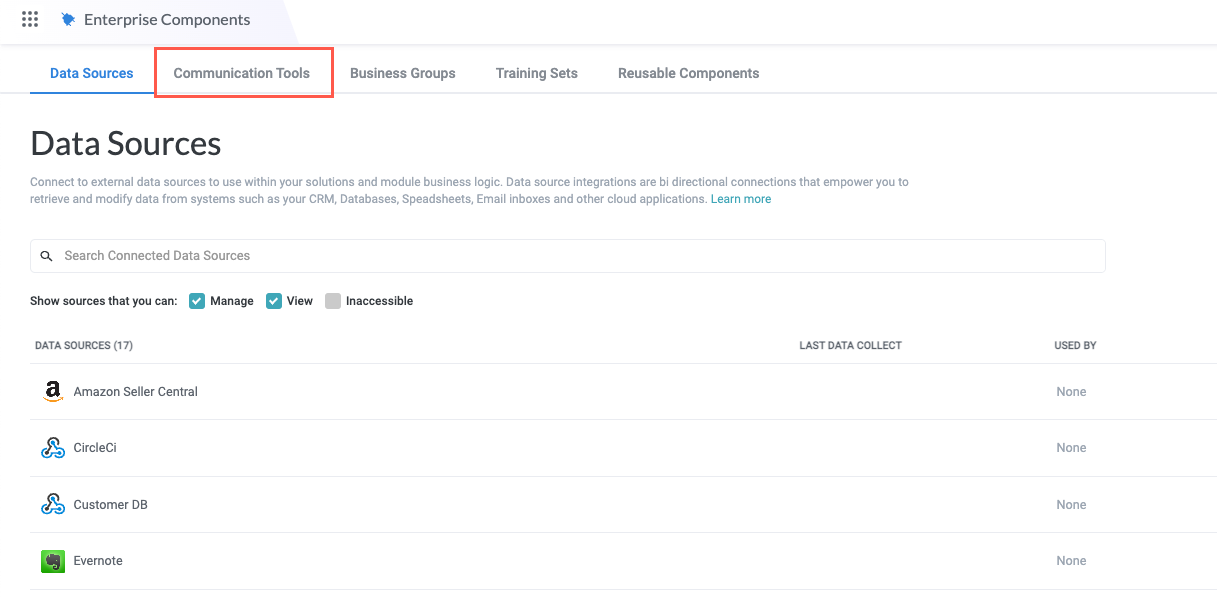
In the Slack section, select New Instance. A new window displays asking you to allow Tonkean to connect to your Slack workspace.
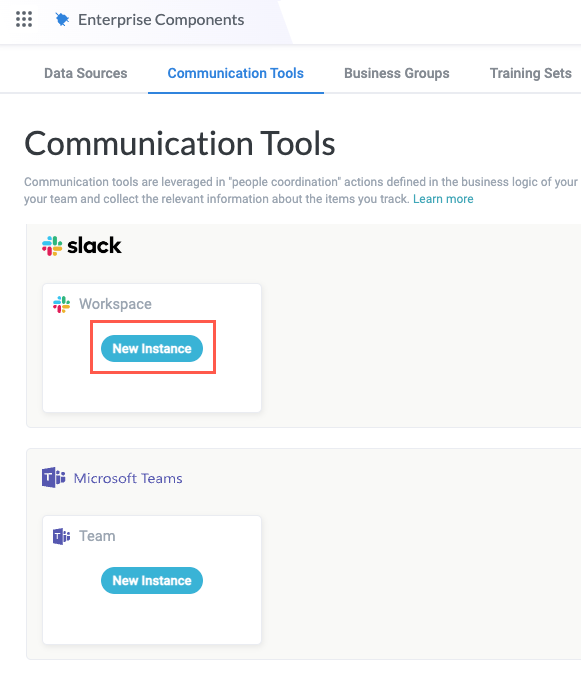
If you are logged into multiple Slack accounts, select the dropdown in the top right and select the Slack workspace you want to connect to Tonkean. When finished, select Allow.
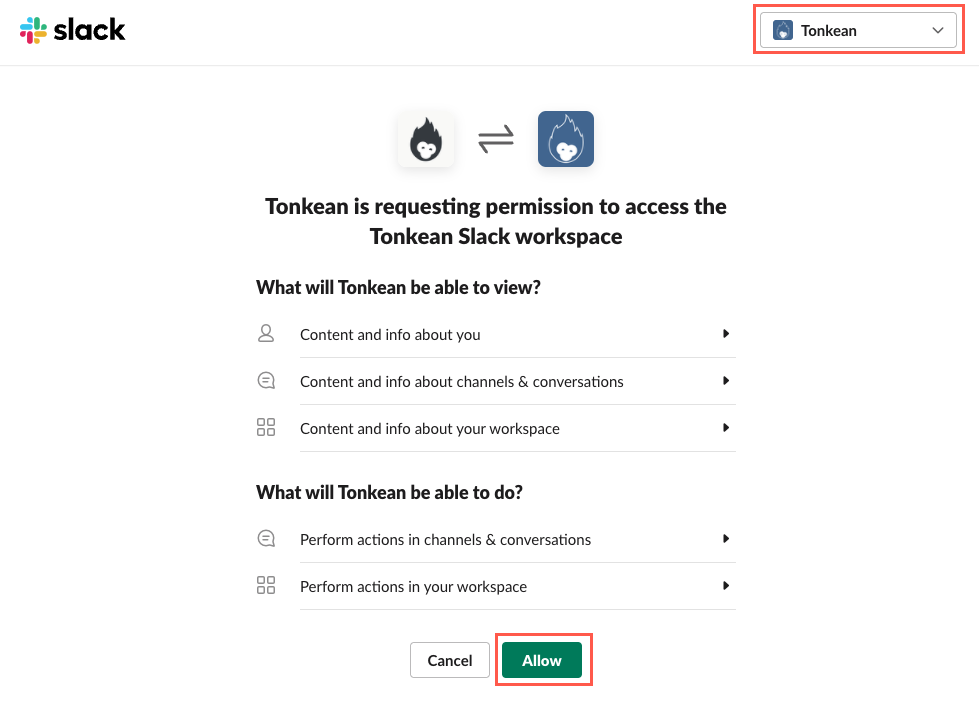
A success message displays in the upper right if Slack was successfully authenticated and connected to Tonkean. The connected Slack instance appears in the Slack section of the Communication Sources screen.
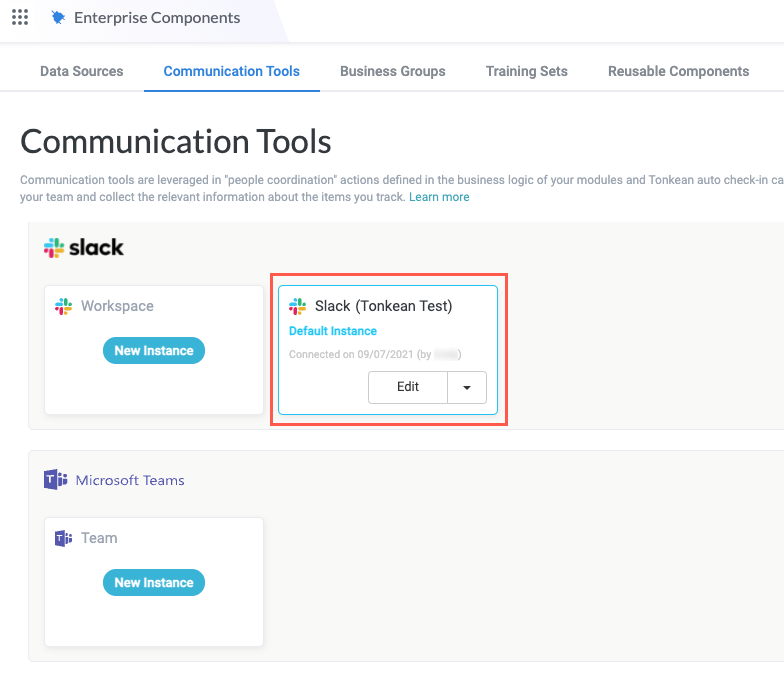
Additionally, Tonkean displays as a connected app in your Slack instance:
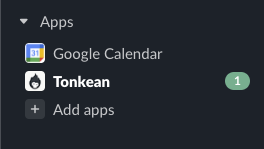
Add Slack as a Data Source
Slack can also be connected as a native data source. With this integration, you can monitor certain conversations and take action in response to specified commands.
To add Slack as a data source, you must first connect Slack as a communication tool.
To add Slack as a data source, follow the steps below:
Select the main nav icon,
 , in the upper left and select Enterprise Components. The Enterprise Components screen displays.
, in the upper left and select Enterprise Components. The Enterprise Components screen displays.Select + New Data Source in the upper right.
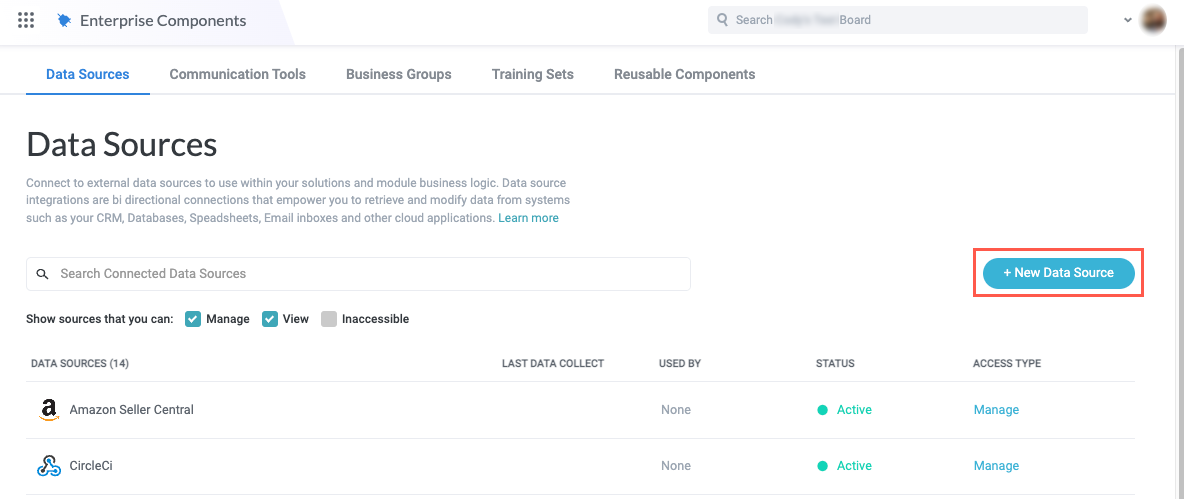
Select Cloud Application. The Add New Data Source window displays.
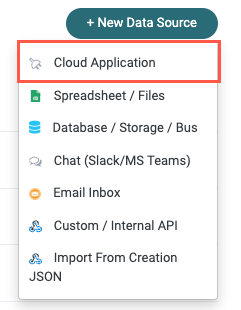
If you select Chat (Slack/MS Teams), you are redirected to the Communication Sources screen where you can connect a chat application as a communication tool.
Enter "Slack" in the search field, then select Slack App. The New Slack Connection window displays.
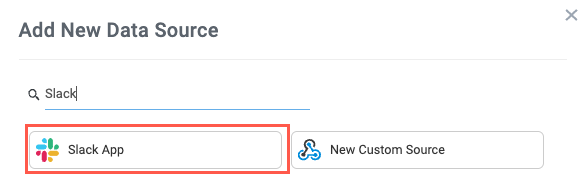
Select Create a new connection. A new window displays asking you to allow Tonkean to connect to your Slack workspace.

If you are logged into multiple Slack accounts, select the dropdown in the top right and select the Slack workspace you want to connect to Tonkean. When finished, select Allow. The Set Up Data Source window displays.

Select the channel or channels you want to monitor. Select the dropdown to choose from all available channels, filtering the list displayed in the dropdown by selecting either Public or Private channels.
Select + Add Channel to monitor additional Slack channels.
To monitor a private channel, you must be a member of the private channel and signed into the relevant Slack workspace when configuring the data source. Tonkean App must also be listed in the Apps section of the Slack workspace.
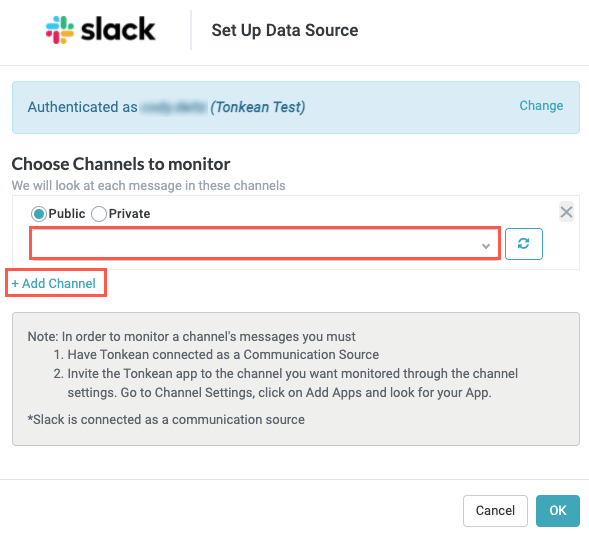
When finished, select OK.
Your Slack instance is connected to Tonkean as a data source. Be sure to provide the relevant solutions access to this data source.
Slack Permissions
When you connect a Slack instance to Tonkean, it's important to note that all of the permissions in Slack (that is, create, edit, read-only) are mirrored in Tonkean. A user is able to create or update in Tonkean anything they are able to create or update in Slack.
Considering these equivalent permissions, make sure that the account you connect has the authority to perform all the actions your process requires in Tonkean while also being careful not to give Tonkean more access to Slack than is necessary.
Monitor Slack as an Intake Source
Like most data sources, you can use Slack as the module intake source:
After creating a new module, select the item tile. The Item Details panel displays.
In the Select Intake Source section, select Chat. The Select Data Source section displays.
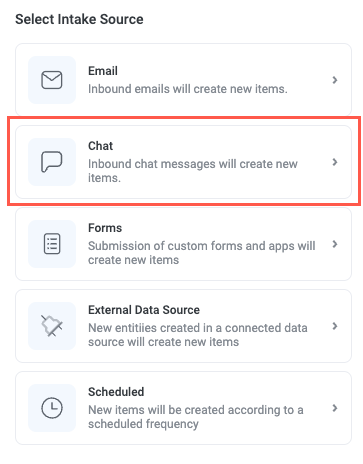
Select the Slack data source you want to connect as the intake source. The connection configuration screen displays.

Select the entity you want to collect, where relevant.
Slack App entities include all available objects in Slack (for example, Channels, Messages, and Users).
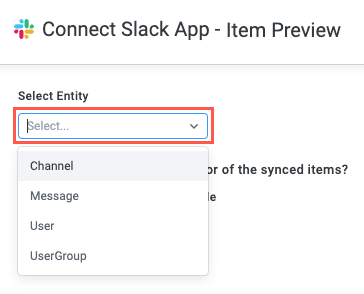
By default, Tonkean collects all entities of the selected type. If you want to filter the entities the module monitors, configure the conditions for the conditions group.
When setting up a new intake source, we recommend always adding a custom filter instead of monitoring all entities of the selected type. This ensures there's a smaller amount of data to monitor and respond to. For example, configuring the filter to monitor messages from a specific channel may be a good place to start.
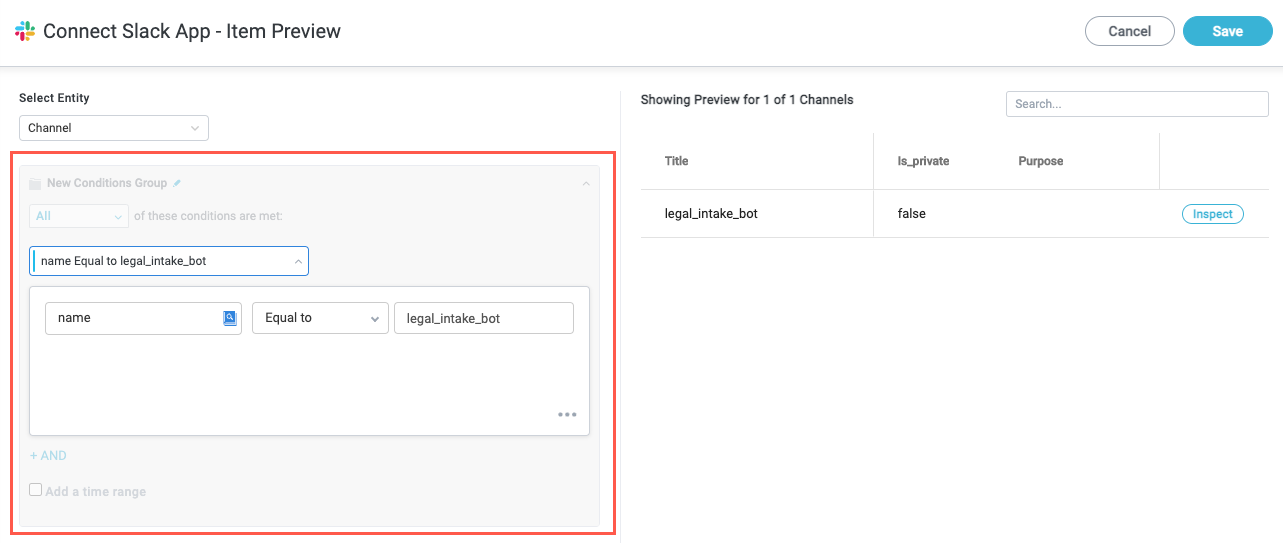
Select who to set as the creator of the items synced from the data source:
The default actor of this module - The module actor, configured in the module settings. For more information about configuring the module actor, see Configure Module Settings.
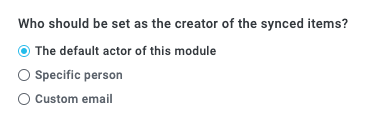
Specific person - Select a specific user from your board.

Custom email - Enter a custom email. Enter the email address manually or dynamically create the address by selecting the insert field button,
 , and using existing fields from your module.
, and using existing fields from your module.
When finished, select Save in the upper right.
Your module is monitoring Slack.
Use Slack as an Action
In addition to monitoring a Slack workspace, you can use actions to create a channel, invite users to a channel, and perform other actions in Slack based on triggers you create. To add a Slack action block, perform the following steps:
On the module builder screen, add an action by selecting the plus icon,
 , to the right of the Do arrow in your work flow. A new action block is created and the Action Block panel displays.
, to the right of the Do arrow in your work flow. A new action block is created and the Action Block panel displays.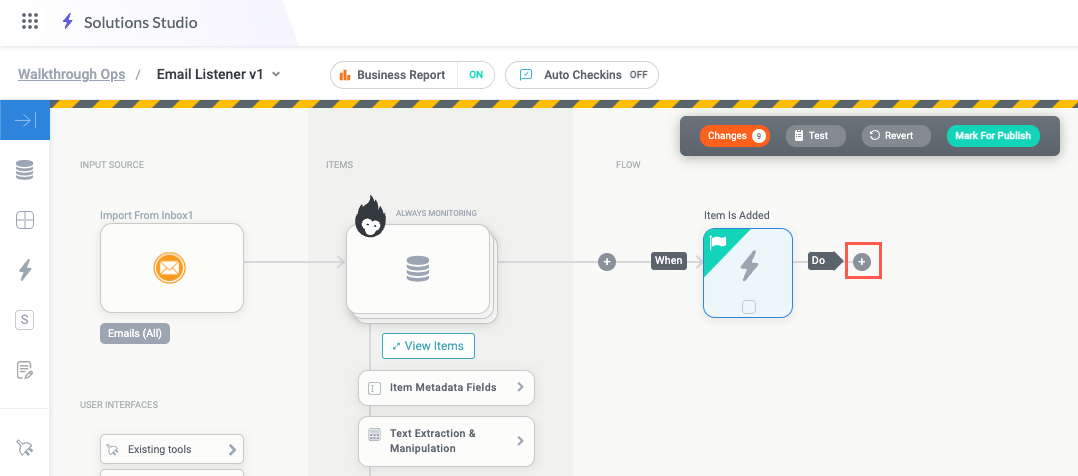
Scroll down to the Data Actions section and select the Slack App action. The Slack action panel displays.
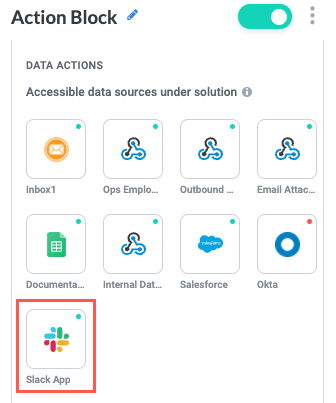
Configure the fields to perform any action relevant to your workflow.
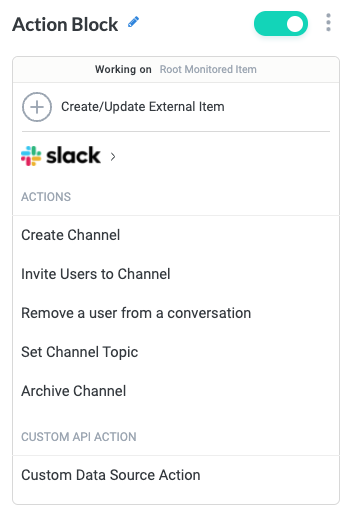
You're leveraging Slack as an integrated part of your module workflow.